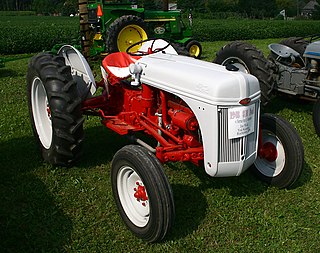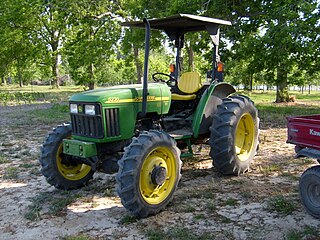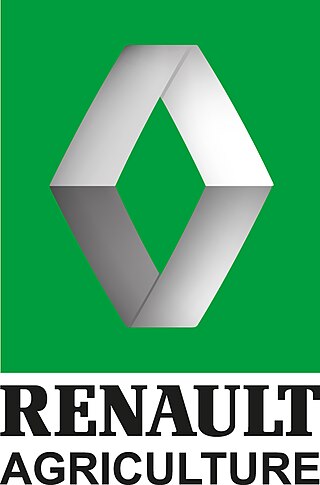Related Research Articles

A tractor is an engineering vehicle specifically designed to deliver a high tractive effort at slow speeds, for the purposes of hauling a trailer or machinery such as that used in agriculture, mining or construction. Most commonly, the term is used to describe a farm vehicle that provides the power and traction to mechanize agricultural tasks, especially tillage, and now many more. Agricultural implements may be towed behind or mounted on the tractor, and the tractor may also provide a source of power if the implement is mechanised.

John Deere was an American blacksmith, businessman, inventor and politician. He founded Deere & Company, one of the largest and leading agricultural and construction-equipment manufacturers in the world. Born in Rutland, Vermont, Deere moved to Illinois and invented the first commercially successful steel plow in 1837.

Deere & Company, doing business as John Deere, is an American corporation that manufactures agricultural machinery, heavy equipment, forestry machinery, diesel engines, drivetrains used in heavy equipment and lawn care equipment. It also provides financial services and other related activities.

John Froelich was an American inventor and entrepreneur, who invented the first stable gasoline-powered tractor with forward and reverse gears. He received several patents relating to tractors and internal combustion engines.

The Waterloo Gasoline Engine Company was the first company to manufacture and sell gasoline powered farm tractors. Based in Waterloo, Iowa, the company was created by John Froelich and a group of Iowa businessmen in 1893, and was originally named the Waterloo Gasoline Traction Engine Company. In 1892, Froelich built a successful gasoline-powered tractor, and the new company was given the opportunity to manufacture and sell the tractor Froelich designed. The tractor was not successful commercially, and of the four tractors built by the company only two were purchased, and these were later returned to the company by unsatisfied customers. In 1895, the company was sold to John W. Miller and renamed the Waterloo Gasoline Engine Company. Miller decided to stop producing tractors and instead focus on building plain gasoline engines.

Farmall was a model name and later a brand name for tractors manufactured by International Harvester (IH), an American truck, tractor, and construction equipment company. The Farmall name was usually presented as McCormick-Deering Farmall and later McCormick Farmall in the evolving brand architecture of IH.

Tractors in India are a major industry and significant contributor to its agriculture output gains.

The John Deere 5220 is a utility/agricultural tractor produced by John Deere, designed for residential and farming use. Manufactured from 2000 to 2004, it has a 3-cylinder, 53 horsepower (40 kW) engine which produces 140 ft⋅lbf (190 N⋅m) of torque at 2400 rpm. It was available in 2wd or Mechanical Front Wheel Drive (4wd) and has a rear hitch capacity of 3,400 lb (1,500 kg). It was mechanically nearly identical to the 5210 that it replaced but in addition to the standard straddle mount operating platform it offered an optional IOOS, and the optional cab was improved over the previous model.

The Massey-Harris Model 81 was a two-plow small-farm tractor built by Massey-Harris from 1941-1948. Introduced to replace Massey's General GG, the 81 was paired with the Model 82 and was very similar to the Model 101 Junior, which first appeared in 1939. It was offered in standard-tread and row-crop versions, as was the Model 20 that followed it. The Model 81 was joined in 1946 by the Model 20, both of which survived in production until 1948.

The Massey-Harris Model 101 was a tractor built by Massey-Harris from 1938 to 1946. Developed under the guidance of James S. Duncan, who gambled corporate losses would drop and won, the 101 introduced the Chrysler L-head inline six. The six would compete with Oliver's straight-six Model 70, while saving money on development of a whole new engine as well as taking advantage of Chrysler's existing parts and service network.
Jacobsen Manufacturing is a former U.S. lawn mower and light-duty tractor manufacturer, in operation there from the early 1920s until around 2020. It was located in Racine, Wisconsin, from 1921 to 2001, when It moved to Charlotte, North Carolina. In 2017, Jacobsen moved from Charlotte to Augusta, Georgia. In 2020, it would relocate to its sister factory of Ransomes-Jacobsen in Ipswich, England, UK. It has been owned by Textron since 1975.

The John Deere Model A is a row crop tractor manufactured by Deere & Company. The A was produced in a wide variety of versions for special-purpose cultivation. It received a styling upgrade in 1939 and electric starting in 1947. With the advent of John Deere's numerical model numbering system, the A became the John Deere 60, and later the 620 and 630, 3010, 3020, 4030, 4040, 4050, 4055, and ended with the 7610.

Renault Agriculture S.A.S. was the agricultural machinery division of the French car manufacturer Renault established in 1918 from its armored military vehicles division. While in operation, Renault Agriculture had various partnerships with major manufacturers and focussed production on tractors. The company was sold between 2003 and 2008 to German rival Claas. Renault Agriculture was dissolved in 2008 and its facilities became part of Claas' tractor division. Claas' tractor division and Renault's Auto Châssis International are Renault Agriculture successors.
The agricultural machinery industry or agricultural engineering industry is the part of the industry, that produces and maintain tractors, agricultural machinery and agricultural implements used in farming or other agriculture. This branch is considered to be part of the machinery industry.

The John Deere 4010 was an American farm tractor in production by the John Deere Company from 1960 to 1963. The 4010 was the primary attraction of the new “10” series known as the “New Generation” or “New Generation of Power” which consisted of four and six-cylinder tractors first introduced in 1959 to replace the two-cylinder tractors which led to the great success of John Deere as a tractor manufacturer until that time. The "10" series tractors were introduced to John Deere dealers in dramatic fashion on August 30, 1960 when dealers from around the world were invited to Dallas, Texas where the entire new series was debuted at the Dallas Memorial Auditorium.

The John Deere Model B tractor was a two-plow row-crop tractor produced by John Deere from 1935 to 1952, with direct successors produced until 1960. The B was a scaled-down, less expensive version of the John Deere Model A. It was followed by the updated 50, 520 and 530 models.

The John Deere Model G tractor was a large three-plow row-crop tractor produced by John Deere from 1937 to 1953, with successor models produced until 1961. It was followed by the 70, 720, and 730.

The John Deere Model M tractor was a two-cylinder row-crop tractor produced by John Deere from 1947 to 1952, with successor models produced until 1960. It was succeeded by the updated 40, 420 and 430 models, as well as the 320 and 330 models that occupied the market positions left vacant by the more powerful 400 series models.

The John Deere Model R tractor was John Deere's first diesel tractor. A large, heavy tractor, it had fixed wheel widths and was not produced as a row-crop tractor with adjustable axles. The R was followed in the John Deere numbered model series by the John Deere 80, 820 and 830 tractors, which represented evolutionary upgrades to the basic R.